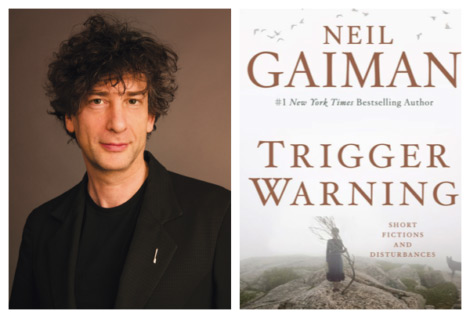“Trigger Warning”: read at your own risk

Be afraid. Be very afraid.
“I wonder, are fictions safe places? And then I ask myself, should they be safe places?” ponders author Neil Gaiman.
In Gaiman’s new book, “Trigger Warning: Short Fictions and Disturbances,” a collection of previously published short horror stories, we are introduced to an entire slew of strange and perplexing characters, scenarios and locations, and the horrors that haunt and inhabit them. In the introduction, Gaiman eloquently explains what horror fiction is, how everyone has their own “triggers,” and why it is important to neither stunt nor sugar coat the beauty or suspense of horror fiction writing.
“What we read as adults should be read, I think, with no warnings or alerts beyond, perhaps: enter at your own risk. We need to find out what fiction is, what it means, to us, an experience that is going to be unlike anyone else’s experience of the story,” Gaiman writes.
Gaiman has penned two other books of short fictions: “Smoke and Mirrors” and “Fragile Things.” “Trigger Warning” wades into new territory with the ambition and scope of the stories told. He is also the author of best-selling novel “American Gods,” which was recently made into an HBO series; the famous “Sand-Man” graphic novel series; and other short fictions, poems, novels, TV show episodes, film scripts and audio theater for both adults and children.
This collection is mainly comprised of short stories, ranging from three pages long to 30 pages long. However, there are also stories in the forms of poems, interview transcripts, and short parts or chapters within short stories. Each is unique and more bizarre than the last, delighting and horrifying in all manner of ways.
The story genres in this collection stray from epic fantasy, to classic Hitchcockian suspense, to whimsical fairy tale, to quirky dark comedy, to Doctor Who-esque science fiction, to the cosmic horror of the unknown — reminiscent of HP Lovecraft — to Lewis Carroll-style absurdity. All of these stories stand out from one another but also blend seamlessly into the fathomless pit of horrors and wonders that is Gaiman’s imagination and nerve.
A true magician of words, he is able to craft such vivid images in your mind, such clearly defined moments and otherworldly concepts that you are completely enveloped in the world he is orchestrating, completely at his mercy. Just within the first four pages of the book, there is a short story that chilled me to the bone as I read its last sentence. And this was in the introduction.
My favorites out of this collection include “My Last Landlady,” a poem chronicling the struggles and slowly building horrors of a renter’s experience with his elderly landlady. Another favorite would be “The Truth is in a Cave in the Black Mountains,” which is a sprawling travel epic bathed in the atmosphere and scope of great fantasy novels. “A Calendar of Tales” is a 12-part collection of short stories, each inspired by Tweets from Gaiman’s readers and each corresponding to a month in the calendar year. Another is an extracanonical Sherlock Holmes story chronicling how the Great Detective begins beekeeping in his old age. Gaiman’s work can go from whimsical, to absurd, to tongue-in-cheek comical, to downright chilling within the same short story.
While readers can admire and feel involved in the stories when they are able to spot the respectful nods to previous authors or classics, Gaiman very much nudges his work into completely unexplored places. He has an uncanny knack for writing about spine-chilling and skin-crawling scenarios in such an often calm and reassuring manner that you are tricked into staying at ease even as the hairs involuntarily rise on your arms.
Gaiman’s attention and commitment to his craft shine through in each of his stories. He has a profound respect for the mythologies and classic fiction that many of his stories reference and are inspired by, and his collection holds so many nods and winks to other fictions you cannot help but go try to search out the sources once you are finished. On top of the excellent fiction presented here, Gaiman has the utmost respect for his readers. He is enthusiastically involved with his fans and this is reflected through his work. He never uses cheap tricks or shoddy plot twists, and his writing always has a touch of self-awareness about it that helps pull readers in and helps them not feel overly intimidated by the genre-bending atmosphere of his stories, while also taking them into completely unexplored territory. Gaiman is both tormentor and guide. And even if we recoil in horror and shock, he manages to pull us back in.
“There are things that wait for us, patiently, in the dark corridors of our lives,” he says. “We think we have moved on, put them out of mind, left them to desiccate and shrivel and blow away; but we are wrong. They have been waiting there in the darkness, working out, practicing their most vicious blows, their sharp hard thoughtless punches into the gut, killing time until we came back that way.”
“Trigger Warning” is a collection that is easy to devour. However, I found myself savoring and slowly processing each story for what a unique piece of writing it was. “Trigger Warning” is almost guaranteed to be enjoyed by seasoned Gaiman fans, but also serves as an excellent introduction and invitation to newcomers to enter into his imagination and strange worlds.
Just watch your step.





